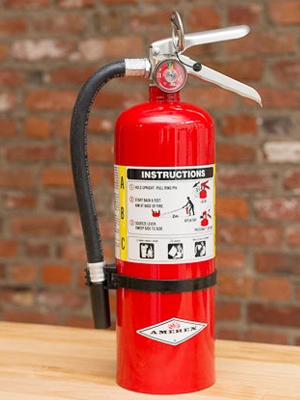Fire Extinguisher

Fire Extinguisher is most important part of Fire Fighting equipment. The Fire Extinguisher capacity, Size and application is as per NFPA 10 & IS 2190 and other FM Global standards.
There are a variety of fires. Each fire type, cannot treated the same way that, is why we have to use different Fire Extinguishers for different fires. For example, a water type Fire Extinguisher cannot be used for an electrical fire. Fire Extinguishers work on the principle that by isolating Oxygen from, the fuel and ignition; the Fire Triangle is effectively broken. Hence, the fire stops immediately. However, Fire Extinguishers are supposed to be used for small fire or fire in an infant stage. For large fires, Fire Extinguishers they might not be useful. So in a sense, you can call Fire Extinguishers as Automatic Fire Extinguishing Systems, useful for fires in their infant stage. But the detection will, remain manual or visual; as seen by the person near the fire. Fires are classified on the basis of their origin or the materials that are causing the fire to burn.
Type A : Here, ordinary materials like wood, paper, cotton, cloth, etc. cause such a fire. Such a fire leaves “ASH” behind, as a residue.
Class B : Highly Flammable liquids, like paints, petrol, gasoline, benzene cause such type of fires. Such liquid, as always kept, protected in a “BARREL” (but not cooking oil)
Class C : The cause of such a fire, electrical circuits malfunctioning. Hence, an object may be charged and cause massive fire. There is a massive “CURRENT” flow which cause the fire. fire caused by flammable gases, e.g., butane, propane or methane
Class D : Combustible metals, or combustible mixture, normally used the industries cause such fires. fire caused by burning metals, e.g. aluminium, lithium or magnesium
Class K : Vegetable oils, fats or Cooking Oils can cause such a fire. Such materials are generally, found in the “KITCHEN”
Extinct Fire Engineers provides Fire extinguishers. Our services cover Supply, installation, testing, commissioning, and maintenance of Fire Extinguishers systems in India last 30+ years.
We are an affluent name in the field of fire protection services and engaged in dealing and providing the most accurate solutions to our clients. We have served 500+ companies over 30+ years in providing safer, better work & residential environment.When it comes to understanding our client’s budgets, expectations, architectural nuances & time; you can lay your trust in our expertise
How to operate Fire Extinguishers?
One can best, operate a Fire Extinguishers, by using the PASS principle:
- P: PULL the pin form the handle.
- A: AIM the nozzle at the base of the fire.
- S: SQUEEZE the handle, and don’t let go.
- S: SWEEP the nozzle from side to side.
Fire Extinguisher: Water Type
Water naturally, extinguishes fire. Such a Fire Extinguisher contains water under pressure. Water can be used only against Type A fires.
Fire Extinguisher: Dry Chemical Type
Dry Chemical Type of Fire Extinguishers can be used in a variety of fire types. Hence they are commonly known as “Multi-purpose Fire Extinguishers.” They can be used in Type A, type B and Type C fires. This is the most popular Fire Extinguisher and is commonly seen in offices, hospitals or homes etc.
Fire Extinguisher: Co2 Type or Co2 Extinguishing System
Such a Fire Extinguisher is used in Type A and type B fires. This is a clean type of Fire Extinguisher, this is because it leaves no residue behind. Hence, such a Fire Extinguisher is used in Server rooms or in Art Galleries.
Fire Extinguisher: Foam Type
Such a Fire Extinguisher is used in Type A and type B fires. After the trigger is pressed, the foam is released from the Fire Extinguisher. The foam floats on the flammable liquid and isolate them from oxygen. However, they leave a residue, which has to be cleaned up.
Fire Extinguisher: Wet Chemical Type
Any kind of electrically non-conductive, volatile, or gaseous fire extinguishing agent that evaporates without leaving a trace is referred to as a clean agent. Clean agent chemical are FM – 200, NOVEC 1230 etc. These extinguisher are